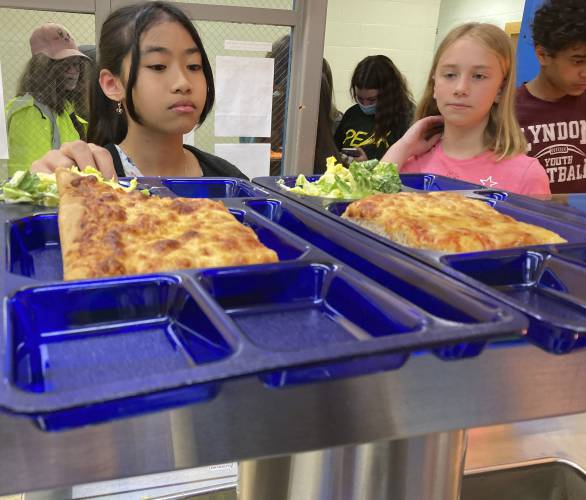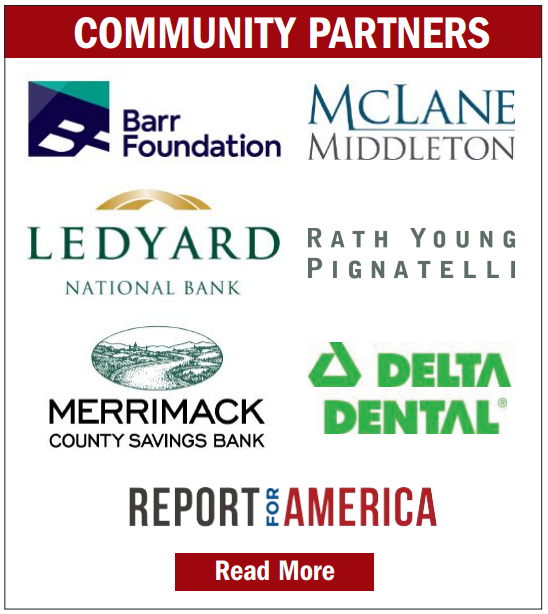School meal debt in Concord tops $90K

Students get lunch of homemade pizza and caesar salad at the Albert D. Lawton Intermediate School, in Essex Junction, Vt., Thursday, June 9, 2022. The pandemic-era federal aid that made school meals available for free to all public school students — regardless of family income levels — is ending, raising fears about the effects in the upcoming school year for families already struggling with rising food and fuel costs. (AP Photo/Lisa Rathke) Lisa Rathke
| Published: 07-02-2024 5:04 PM |
Before the pandemic, Concord School District expected between $7,000 and $15,000 in outstanding school lunch debt at the end of the year. This past school year, the number hit $93,000.
It continues a post-pandemic trend of swelling debt: Federal COVID programs providing free meals for all students expired last year and, nationwide, districts have been left on the hook to recoup meal costs that families cannot or do not pay for.
The Concord School Board originally budgeted $35,000 this past year for anticipated meal debt — last year, the total was $62,000. While efforts to recoup payments from parents continue, it voted Monday to allocate funding to cover the tab with the fiscal year closing June 30.
In New Hampshire, students from families making 130% or less of the federal poverty level — $40,560 for a family of four — are eligible for free meals, while those from families making 185% of the federal poverty level — or $57,720 for a family of four — are eligible for reduced price meals. In the 2022-2023 school year, 37,380 students enrolled statewide.
About $9,000 of the debt in Concord came from students who receive free or reduced lunch, according to business administrator Jack Dunn. That aid applies to meals; if a student, for example, gets just a carton of milk, that is not a meal covered by the program, and gets charged in full to their account.
The other $84,000 comes from students who don’t receive free or reduced lunch support.
That doesn’t necessarily mean that all of those students come from families that can easily afford to pay: Some may be eligible for the program but did not apply. Others may come from families that fall outside the requirements but still struggle to make ends meet.
In Concord, 1,210 students district-wide are enrolled in free or reduced lunch. With some overlap, there are 821 students with outstanding debt, according to figures shared by the district.
Article continues after...
Yesterday's Most Read Articles
After federal universal free lunch programs ended, many states — including Maine, Vermont and Massachusetts — passed laws making universal free lunch a permanent fixture. Feeding America reports that 13.8% of children in Merrimack County — or just under 4,000 kids — are food insecure, and that more than half of them are ineligible for free or reduced meals at school.
The New Hampshire legislature has, multiple times, rejected legislation to increase eligibility for the program. This year, a bill stemming from a longtime push by Concord Rep. Art Ellison would have increased eligibility to 350% of the poverty level — $109,200 for a family of four. Weeks after Ellison passed away, and with his family looking on, his colleagues in the house voted to table his bill by one vote.
Concord also voted Monday to submit a resolution to the upcoming meeting of the New Hampshire School Boards Association endorsing universal free lunch. The board brought the same resolution to the statewide meeting last year; it failed.
Catherine McLaughlin can be contacted at cmclaughlin@cmonitor.com.







 Henniker ponders what is a ‘need’ and what is a ‘want’
Henniker ponders what is a ‘need’ and what is a ‘want’ Boscawen residents vote to fund major renovation of public works building
Boscawen residents vote to fund major renovation of public works building ‘Voting our wallets’: Loudon residents vote overwhelmingly against $1.7M bond for new fire truck
‘Voting our wallets’: Loudon residents vote overwhelmingly against $1.7M bond for new fire truck In Pembroke, Education Freedom Accounts draw debate, voters pass budget
In Pembroke, Education Freedom Accounts draw debate, voters pass budget
